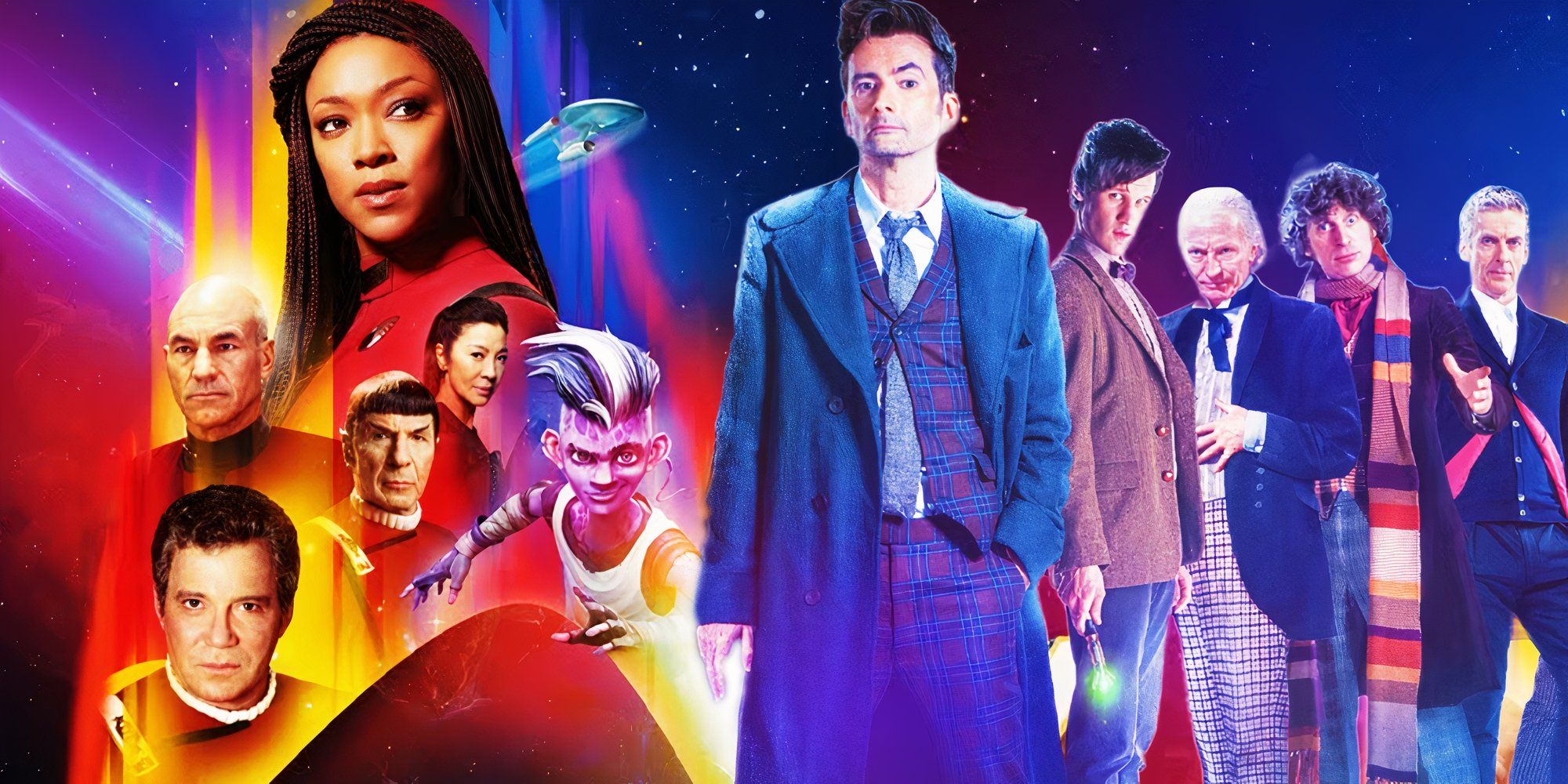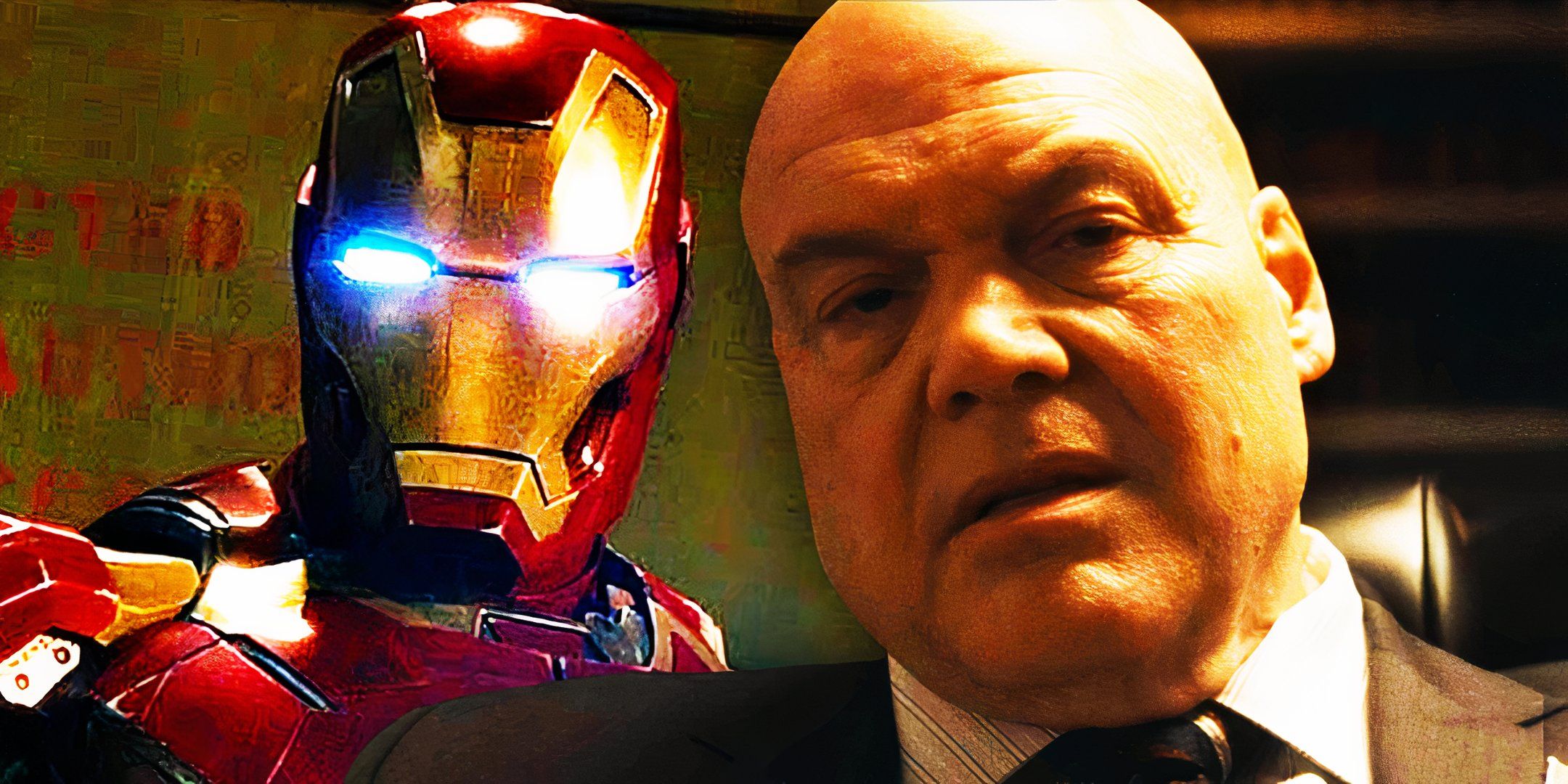14 Best Doctor Who Episodes To Win Star Trek Fans Over
Summary Star Trek and Doctor Who have deep-rooted connections dating back to the 1960s, sharing themes of hope and optimism for the future.
Episodes like "Frontier in Space" and "The Aztecs" showcase the parallels between Doctor Who and Star Trek's storytelling and moral dilemmas.
Modern Doctor Who episodes like "Dot and Bubble" and "Flux" offer a fresh take on sci-fi themes and are perfect for Star Trek fans looking for new adventures.
With a mobile game crossover and a joint panel at San Diego Comic-Con, Star Trek fans intrigued by Doctor Who may need a handy episode guide to get them started. Although Star Trek and Doctor Who's links have become more pronounced in recent months, the connections between two of the most beloved TV sci-fi franchises actually go back decades. Star Trek: The Original Series debuted on UK screens on July, 12, 1969, in the exact same Saturday evening slot vacated by Patrick Troughton's final season of Doctor Who less than a month earlier.
The UK's broadcast of the first Star Trek TV show coincided with the lead-up to the Moon landing, scheduled to take place a week later. Months earlier, the Doctor Who serial "The Seeds of Death" had depicted a future where space travel had become unfashionable in the decades after man landed on the Moon. The UK listings magazine Radio Times (via BBC Genome) contained an emotive listing for Star Trek's second pilot, "Where No Man Has Gone Before", which perfectly highlights this key difference between Doctor Who's British pragmatism and the idealism of TOS:
Today the moon - tomorrow the cosmos? The first is fact, the second is so far fiction. Nevertheless this new adventure series looks forward to a not-too-distant future when man will be exploring and colonising the worlds beyond us.
Related 10 Times Star Trek & Doctor Who Crossed Over Doctor Who and Star Trek are TV's two biggest sci-fi franchises, but they're not arch-rivals, and regularly make affectionate nods to each other.
Despite their differing approaches and cultural influences, Star Trek and Doctor Who share an optimism and hope for the future. For six decades, both shows have promoted peaceful resolution to the intergalactic crises faced by their protagonists. The Doctor never carries a gun, while Star Trek's brave Starfleet officers always have their phasers set to stun. Some of Doctor Who's best episodes also share story ideas and similar moral dilemmas to the very best of Star Trek, making them a great primer for any Trek fan who wishes to step into the TARDIS.
14 Frontier in Space - Third Doctor, 1973
Perfect for fans of Star Trek VI: The Undiscovered Country
Close
"Frontier in Space" throws the Third Doctor (Jon Pertwee) and his companion Jo Grant (Katy Manning) into the center of a political conspiracy with wide-ranging ramifications for the rest of the universe. Framed for agitating tensions between a united Earth government and the Draconians, the Doctor is sent off to a penal colony, where he narrowly avoids an assassination attempt. The similarities between "Frontier in Space" and Star Trek VI: The Undiscovered Country, not to mention the overall storyline about intergalactic politics, makes it perfect for easing fans into the world of Doctor Who.
David Warner, who played Chancellor Gorkon in Star Trek VI: The Undiscovered Country, has also played an alternate reality Doctor in a series of Doctor Who audio dramas.
13 Enlightenment - Fifth Doctor, 1983
For fans of Q and Star Trek's naval traditions.
Close
There's a long naval tradition in Star Trek, but that's not why a Doctor Who story about the Fifth Doctor (Peter Davison) participating in an outer space boat race should be appealing to Trek fans. "Enlightenment" introduces the Eternals, a race of bored gods that toy with humanity, staging elaborate competitions. While the Eternals are stuffier, less flamboyant versions of Star Trek's Q (John de Lancie) or Trelane (William Campbell), they do feel akin to those omnipotent game players. For added color, the sailing ships in space will recall the Bajoran solar-sailing ship from Star Trek: Deep Space Nine.
12 The Aztecs - First Doctor, 1964
Doctor Who establishes its own Prime Directive
Close
While Doctor Who doesn't have Starfleet's Prime Directive, it does have its own policy of non-intervention, the rules of which are routinely bent. "The Aztecs" is the first Doctor Who story to set these rules, with the First Doctor (William Hartnell) memorably telling his companions that they "cannot rewrite history, not one line". However, the Doctor's companion Barbara (Jacqueline Hill) attempts to save the Aztec people regardless of this. "The Aztecs" is a thought-provoking morality play that sits neatly alongside the best of Star Trek's episodes about the moral complexities of stepping in to save doomed civilizations.
11 Dot and Bubble - Fifteenth Doctor, 2024
Doctor Who's cynical colony world shows we need Roddenberry's utopia.
Close
Doctor Who season 14, episode 5, "Dot and Bubble" was a powerful subversion of Star Trek's computer-controlled planet trope. The Fifteenth Doctor (Ncuti Gatwa) and Ruby Sunday (Millie Gibson) try to save the colonists of Finetime from their social media apps, only to discover a much darker truth. While the popularity of Charlie Brooker's Black Mirror has likely led to modern Star Trek giving social media allegories a swerve, Doctor Who's "Dot and Bubble" takes some familiar Trek tropes and repackages them for a modern audience.
10 Turn Left - The Tenth Doctor, 2008
Doctor Who's version of DS9's The Visitor.
Close
"Turn Left" is one of the best episodes of Russell T Davies' first Doctor Who era, and shares similar themes to Star Trek: Deep Space Nine season 4, episode 3, "The Visitor". Both episodes are high concept alternate reality tales that have an emotional realism to their storytelling and performances. While Star Trek fans won't recognize the events that the Tenth Doctor (David Tennant) fails to avert in "Turn Left", the emotional performance by Catherine Tate is more than enough to sell the impact of each tragedy. Much like DS9's "The Visitor", "Turn Left" is a powerful piece about loss and the impact of one's choices.
9 The Hungry Earth/Cold Blood - Eleventh Doctor, 2010
Voyager borrowed a classic Doctor Who storyline.
Close
"The Hungry Earth/Cold Blood" is a retelling of the classic Third Doctor serial, "Doctor Who and the Silurians", but this time featuring the Eleventh Doctor (Matt Smith). Both stories focus on the complex relationship between humanity and their predecessors, the Silurians, a species of evolved reptiles. In "The Hungry Earth", the Eleventh Doctor gets a second chance to bring peace to both parties, but it's made difficult by prejudice and distrust from humans and Silurians alike. The Star Trek: Voyager episode "Distant Origin" introduced the Voth, a variation on the same idea as the Silurians, who left Earth behind to travel the stars.
8 The Tomb of the Cybermen - Second Doctor, 1967
"Resistance is useless"
Close
The Silurians aren't the only Doctor Who monster that Star Trek has borrowed from over the years. The Borg Collective's "resistance is futile" catchphrase is eerily similar to that of the Cybermen in Doctor Who, who tell the Second Doctor (Patrick Troughton) that "resistance is useless". In "The Tomb of the Cybermen", the Second Doctor joins an archeological dig that results in the reawakening of his old enemies, the Cybermen. Combining both the greatest love and greatest fear of Captain Jean-Luc Picard (Patrick Stewart), "The Tomb of the Cybermen" is a Star Trek fan's best intro to Doctor Who's answer to the Borg.
The 2012 Star Trek: The Next Generation/Doctor Who crossover comic Assimilation² saw the Borg and the Cybermen team up against the Eleventh Doctor and the crew of the USS Enterprise-D.
7 Vengeance on Varos - Sixth Doctor, 1985
The Gamesters of Triskelion for the age of video nasties.
Close
The Doctor Who serial "Vengeance on Varos" is like Star Trek: The Original Series' "The Gamesters of Triskelion" for the age of video nasties. The Sixth Doctor (Colin Baker) and Peri (Nicola Bryant) land the TARDIS on Varos, a planet with a brutal approach to reality television. Varos' brutal entertainment is designed to keep the masses docile while corporate interests strip the planet of their minerals. In a classic Star Trek set-up, the Sixth Doctor and Peri join a band of rebels to overthrow the oppressive regime. It's bleaker than the average Doctor Who story, but retains Star Trek's sense of justice.
Both Colin Baker and Nicola Bryant have appeared in the fan-made webseries Star Trek Continues.
Related Every Doctor Who Actor Who Appeared In Star Trek Star Trek and Doctor Who remain two of the biggest science fiction franchises, and several actors have made appearances in both.
6 City of Death - Fourth Doctor, 1980
A time travel comedy to rival Star Trek IV: The Voyage Home.
Close
"City of Death" is one of the best Doctor Who stories of all time, primarily for its comic script, inventive time travel storyline and Parisian locations. In "City of Death", the Fourth Doctor (Tom Baker) and Romana (Lalla Ward) are embroiled in a plot to steal the Mona Lisa to fund time travel experiments that will wipe out life on Earth. Both "City of Death" and Star Trek IV: The Voyage Home comment on subjects that are still incredibly relevant today, from the rise of AI art to the ecological crisis facing humanity, but do so with a great deal of wit and humor.
5 The Empty Child/The Doctor Dances - Ninth Doctor, 2005
"...give me some Spock"
Close
It's not only Star Trek: Lower Decks' Lieutenant Beckett Mariner (Tawny Newsome) who thinks Spock is hot. In the classic Doctor Who two-parter "The Empty Child/The Doctor Dances", Rose Tyler (Billie Piper) complains that the Ninth Doctor (Christopher Eccleston) isn't "more Spock." However, Star Trek references aside, the Steven Moffat two-parter is a chilling sci-fi horror about medical technology gone wrong, rewriting all of humanity in the image of a scared little boy in a gas mask. Strange New Worlds season 2 recently told a similar story, albeit as a comedy, when alien technology accidentally removed his Vulcan DNA.
4 Survival - Seventh Doctor, 1989
Doctor Who has its own Genesis Planet.
Close
"Survival" was the final story broadcast in Doctor Who's classic era, and it's fair to say the show went out with a bang. While "Survival" rightly gets plaudits for its believable contemporary Earth setting, the planet of the Cheetah People is a fascinating sci-fi idea. Much like the Genesis Planet in Star Trek III: The Search for Spock, the Cheetah People's planet was connected to the emotions of its native species. After years of savage violence on the planet, it starts to break down, forcing the Seventh Doctor (Sylvester McCoy) and his companion Ace (Sophie Aldred) to suppress their latent savagery to escape.
3 Oxygen - Twelfth Doctor, 2017
"Space, the final frontier... Final because it wants to kill us."
Close
Fans of Star Trek: Enterprise may enjoy the Peter Capaldi episode "Oxygen" from Doctor Who series 10, given that its vision of space travel isn't the clean and sanitized version of other Star Trek shows. "Oxygen" is a story about the harsh realities and the life-threatening danger of early space travel, making it a strong companion piece to Scott Bakula's Enterprise. However, once again, Doctor Who has a slightly more cynical vision of the future, predicting a capitalist space program that charges astronauts for their own oxygen.
Russell T Davies wanted Doctor Who to crossover with Star Trek: Enterprise way back in 2004, a year before Enterprise was cancelled and RTD's first series as showrunner aired.
Related What We Know About RTD's Unmade Star Trek & Doctor Who Crossover According to Russell T. Davies, there were talks about a Star Trek and Doctor Who crossover, but what would it be about and why didn't it happen?
2 Wild Blue Yonder - Fourteenth Doctor, 2023
A bottle episode that 1990s Star Trek would envy.
Close
"Wild Blue Yonder" is a chilling bottle episode that recalls some of the strangest, most atmospheric episodes of Star Trek: The Next Generation. When the Fourteenth Doctor (David Tennant) and Donna Noble (Catherine Tate) arrive at Doctor Who's version of the Galactic Barrier, they find the No Things, non-corporeal beings that want to mimic the Doctor and Donna's humanoid forms. With a storyline that recalls the second Star Trek pilot episode, "Where No Man Has Gone Before" and hallucinatory body horror akin to TNG's "Phantasms", it's a great introduction to the weirder end of the Doctor Who spectrum.
1 Flux - Thirteenth Doctor, 2021
An epic adventure across time and space bigger than any Star Trek movie.
Close
If there's a Doctor Who story that distills everything that the show can do, it's the six-part Thirteenth Doctor epic, "Flux", which aired in 2022. An adventure that spans all time and space from the Crimean War to the end of the universe, "Flux" features some of Doctor Who's best monsters, including the Klingon-like Sontarans. On top of this, it introduces the idea of the multiverse to Doctor Who, just as J.J. Abrams' movie did for Star Trek in 2009.
Doctor Who's "Flux" is perfect for Star Trek fans who feel that the modern, serialized, Trek shows are too slow, because the story barely stops to draw breath. From the atmospheric and creepy Halloween opening to the climactic space battle with some of Doctor Who's biggest villains, it's a non-stop thrill ride. With its space battles, terrifying monsters, and high-concept ideas like time as a sentient organism, "Flux" is a Star Trek fan's perfect primer for everything that Doctor Who is, or could be.











COMMENTS